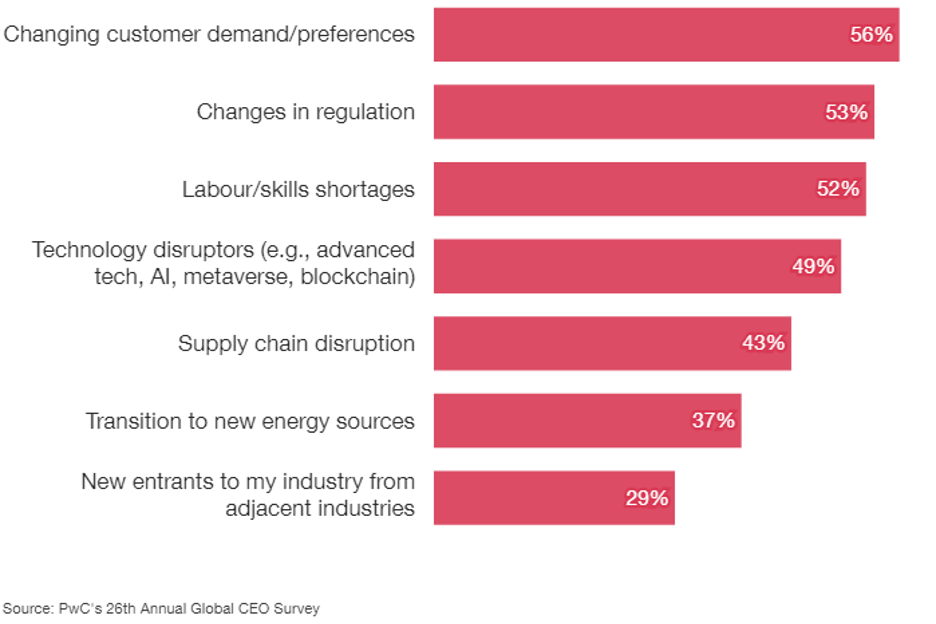In today’s fast-paced and ever-changing business landscape, CEOs face a dual imperative: staying ahead of global market trends and effectively expanding their businesses internationally. The data is clear: staying the course may not be a viable option.
In fact, a staggering 40% of global CEOs believe that their organizations may not remain economically viable within a decade if they continue on their current path. PwC’s 26th Annual Global CEO Survey is a prime resource showcasing the urgency of adaptation and innovation. According to this survey, one of the most pressing trends that CEOs are scrambling to address is that of changing customers demand and preferences.

In this article, we will take a closer look at the critical global market trends that have a direct impact on the international expansion strategies that CEOs are eyeing for in 2024.
The Race for the Future
The first set of questions CEOs must grapple with reflects the race to anticipate and address long-term threats to their companies, society, and the planet itself. As they strive to remain ahead of these challenges, several key global market trends come to the forefront.
1. Generative AI Boosts Business Productivity – But Is It The Answer?
Generative AI is gaining significant attention and is projected to hold a substantial share of the AI market in the next three years, estimated at approximately 30% and valued at around $60 billion. The technology behind generative AI relies on large language models (LLMs) that are trained on vast amounts of text data.
These models understand contextual relationships, patterns, and can generate content with high accuracy in milliseconds. The potential applications of generative AI are vast. It can be employed for:
- Text generation,
- Language translation,
- Content summarization,
- Sentiment analysis, and even
- Conversational ChatBots.
Many global executives believe that AI models will play a crucial role in their organizations in the next five years, reducing working hours by up to 40%.
Generative AI’s influence isn’t limited to one industry. For example, in healthcare, startups like Syntegra generate synthetic patient data, maintaining privacy and efficiency. In the software development realm, platforms like GitHub’s Copilot provide autocomplete-style coding suggestions, significantly speeding up the development process.
Moreover, the advertising industry is set to be transformed by AI-powered ads, with companies like Google and Meta planning to use AI to generate ads and content for their platforms. However, it requires extensive management as the 10-20% error rate may have long-term consequences without proper supervision.
2. E-Commerce Growth Persists Post-Pandemic
E-commerce has witnessed extraordinary growth, accelerated by the pandemic, which reshaped consumers’ shopping habits. During the pandemic, e-commerce experienced a decade’s worth of growth in just three months. Although the growth rate has slowed in today’s hybrid work environment, it continues to expand steadily.
In 2021, global e-commerce sales reached $5.2 trillion. In 2023, it stood at $6.3 trillion. A similar trend expected with a projected growth rate of 56% over the next four years, reaching $8.1 trillion by 2026.

E-commerce’s share of total retail sales has seen an increase from 14% in 2019 to over 22% in 2023. Specific sectors like electronics, home improvement, and home furnishings are maintaining an impressive post-pandemic growth. The furniture industry, for instance, is estimated to grow from $149 million in e-commerce revenue in 2023 to $208 million by 2025.
CEOs are continually embracing e-commerce, and new opportunities arise daily. Disney, for example, transitioned toward e-commerce under Robert Iger’s supervision. Companies like Your Super, a superfood supplement provider, similarly thrived during the pandemic due to its online presence.
3. 5G For Better Data Collection & Artificial Intelligence
The emergence of 5G mobile networks is set to revolutionize business operations. 5G promises higher data speeds, improved dependability, and a latency score of less than 10 milliseconds. This allows for real-time data collection and analysis essential for AI and automation. Businesses are already tapping into 5G’s potential.
BMW, for instance, employs 5G technology to locate machines, cars, tools, and parts within its factory in real-time with remarkable accuracy. Telemedicine benefits greatly from 5G’s high speeds, enabling real-time video and remote patient monitoring. Moreover, CEOs leverage 5G connectivity through the Internet of Things (IoT) are seeing improved business operations and are therefore able to offer new services.
The agribusiness industry is expected to integrate 5G and IoT for tasks like soil monitoring, harvest assessment, and livestock tracking. As 5G technology continues to expand, the potential applications and opportunities are vast. CEOs can use AI and data collectively for better strategic planning.
4. Employees Preferring Remote & Hybrid Work
The pandemic accelerated the shift toward remote work, with 71% of Americans working exclusively from home during its peak. This trend continues, as 56% of full-time U.S. employees have jobs that can be done remotely, amounting to 70 million workers in 2023.
Notably, employees with a college degree are more likely to have access to remote and hybrid work environments. Research indicates that those with a bachelor’s degree or higher are five times more likely to work from home than those with less education.
Many employees who experienced remote work are hesitant to return to the office. A 2022 survey reported that 78% remote workers wish to continue with this arrangement. A significant portion is willing to accept pay cuts to maintain workplace flexibility. This is why many industries are cruelty experiencing talent gaps.
While remote work offers financial benefits to employees, business leaders express concerns about productivity. Companies are turning to monitoring technology to ensure employee productivity, leading to the adoption of screen monitoring, keystroke recording, and facial recognition tools. While remote work opens new, more cost-effective doors towards international expansion, CEOs need to manage hybrid work effectively to ensure that it does not impact productivity.
5. Businesses Expand Ads, Communities, & Commerce on Social Media
Social media knows no bounds, presenting a viable marketing strategies for CEOs on international ventures. A social media presence is now an integral part of business operations. Social media usage is steadily increasing. As a result, more than 50% of Chief Marketing Officers (CMOs) plan to increase their spending on social media ads, and platforms like TikTok are gaining prominence.
Brands are shifting toward authentic influencers and micro-influencers, realizing higher engagement and conversion rates. Social commerce is also on the rise, with predictions indicating substantial growth, reaching $1.2 trillion by 2025. The influence of social media in marketing is here to stay, and CEOs can make the most out of this by collaborating with CMOs.
6. Companies Focus on Sustainability
Sustainability has become a key focus for businesses in response to growing consumer demand. Studies show that sustainability efforts and CSRs contribute to increased customer loyalty, even though the financial impact on the bottom line is yet to be fully realized.
A circular economy, which emphasizes reusing and recycling materials, holds the potential for significant savings and reduced environmental impact. CEOs can use the goodwill that sustainability and CSRs generate to get a sympathy bump from new, international markets. This is particularly the case where the target market is Gen Z, the organization is promoting an employee-first (for example hybrid environment) work culture.
Today, CEOs are navigating an ever-evolving business landscape marked by technological advancements, changing work paradigms, and an increasing emphasis on sustainability. To stay ahead of the curve, it’s essential for CEOs to adapt their strategies and leverage these global market trends for international expansion and long-term success. In the face of these challenges, innovation and adaptability remain the keys to thriving in the business world of 2024 and beyond.


0 Comments